
The Digital Archeology of AOL Search: A Personal Journey into Web Scraping
Let me take you on a journey through the fascinating world of web scraping, where seemingly forgotten digital landscapes hold treasure troves of information. When most technologists have written off AOL Search as a relic of internet history, I saw something different—a unique data ecosystem waiting to be explored.
My fascination with AOL Search began not as a technical challenge, but as a curiosity about digital memory. Imagine a search engine that once connected millions of users, now existing as a quiet archive of early internet interactions. This is where our adventure into web scraping begins.
Understanding the AOL Search Ecosystem: More Than Just a Nostalgic Platform
AOL Search isn‘t just another search engine—it‘s a living digital museum. Founded in 1985, this platform witnessed the internet‘s transformation from a niche technology to a global communication network. While giants like Google and Bing dominate today‘s search landscape, AOL Search represents a critical chapter in digital evolution.
The Unique User Demographics of AOL Search
What makes AOL Search fascinating isn‘t just its technology, but its user base. Unlike mainstream search platforms, AOL continues to attract a distinct demographic—primarily older users who value simplicity and familiarity. This unique audience creates a data ecosystem that differs dramatically from more aggressive, algorithm-driven platforms.
The Technical Foundations of Effective Web Scraping
Web scraping isn‘t just about extracting data—it‘s about understanding digital architecture. When approaching AOL Search, you‘re not merely collecting information; you‘re navigating a complex technological landscape with its own rules, challenges, and hidden pathways.
Legal and Ethical Considerations: Navigating the Compliance Maze
Before diving into extraction techniques, let‘s address the critical aspect of legal compliance. Web scraping exists in a nuanced legal environment where technological capability meets ethical responsibility. AOL Search, like many platforms, has specific terms of service that demand careful navigation.
Your first step isn‘t writing code—it‘s understanding boundaries. Carefully review AOL‘s robots.txt file, analyze their terms of service, and develop a scraping strategy that respects both technological and legal limitations.
Advanced Scraping Methodologies: From Concept to Execution
Architectural Approach to Data Extraction
Successful AOL Search scraping requires a multi-layered approach. Think of it like archaeological excavation—you‘re not just grabbing surface-level data, but carefully mapping and understanding the entire digital terrain.
Your primary tools will include:
- Sophisticated request management libraries
- Dynamic IP rotation mechanisms
- Advanced parsing frameworks
- Intelligent error handling systems
Technical Implementation: A Step-by-Step Breakdown
Implementing an effective AOL Search scraper involves several sophisticated stages:
Initial Configuration: Establish a robust Python-based extraction environment using libraries like Scrapy and Selenium.
Request Management: Develop intelligent request throttling to minimize server load and avoid detection.
Authentication Handling: Create mechanisms to simulate authentic browser interactions, managing complex session dynamics.
Data Parsing: Implement advanced HTML and XPath parsing techniques to extract structured information efficiently.
Real-World Scraping Scenarios: Practical Applications
Web scraping AOL Search isn‘t just a technical exercise—it‘s a gateway to unique insights. Researchers, marketers, and analysts can uncover remarkable patterns by understanding this platform‘s distinctive data landscape.
Case Study: Demographic Trend Analysis
In one fascinating project, we used AOL Search scraping to analyze generational content consumption patterns. By extracting and analyzing search trends, we discovered nuanced information about how different age groups interact with online content.
Performance Optimization: Pushing Technological Boundaries
Effective web scraping is an art of balance—between extraction speed, data quality, and system respect. Your scraping architecture must be both powerful and considerate.
Concurrent Processing Strategies
Implement asynchronous processing models that allow simultaneous data collection without overwhelming target servers. Use Python‘s asyncio library to create scalable, efficient extraction pipelines.
Emerging Challenges in Web Scraping Landscape
The web scraping world is in constant evolution. Anti-scraping technologies become increasingly sophisticated, requiring continuous adaptation and learning.
Future-Proofing Your Extraction Techniques
Stay ahead by:
- Continuously updating extraction methodologies
- Investing in machine learning-driven adaptation techniques
- Developing flexible, modular scraping architectures
Conclusion: Your Gateway to Digital Discovery
Web scraping AOL Search represents more than a technical challenge—it‘s an opportunity to explore digital history, uncover hidden insights, and transform seemingly obsolete platforms into valuable research resources.
Remember, successful web scraping isn‘t just about code—it‘s about curiosity, respect, and a deep understanding of digital ecosystems.
Your Next Steps
- Study advanced scraping methodologies
- Build experimental extraction prototypes
- Engage with legal and technological communities
- Never stop learning and exploring
The world of web scraping is your digital playground. Embrace the challenge, respect the technology, and unlock remarkable insights.










